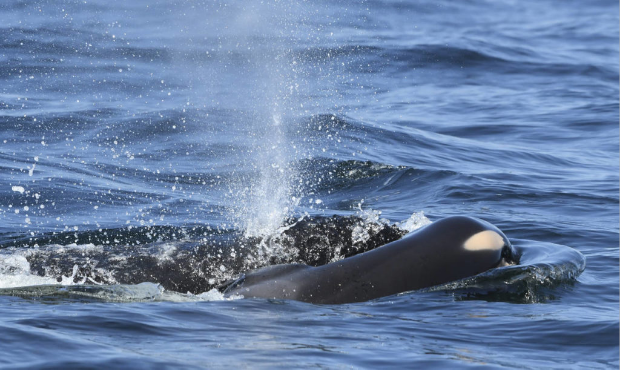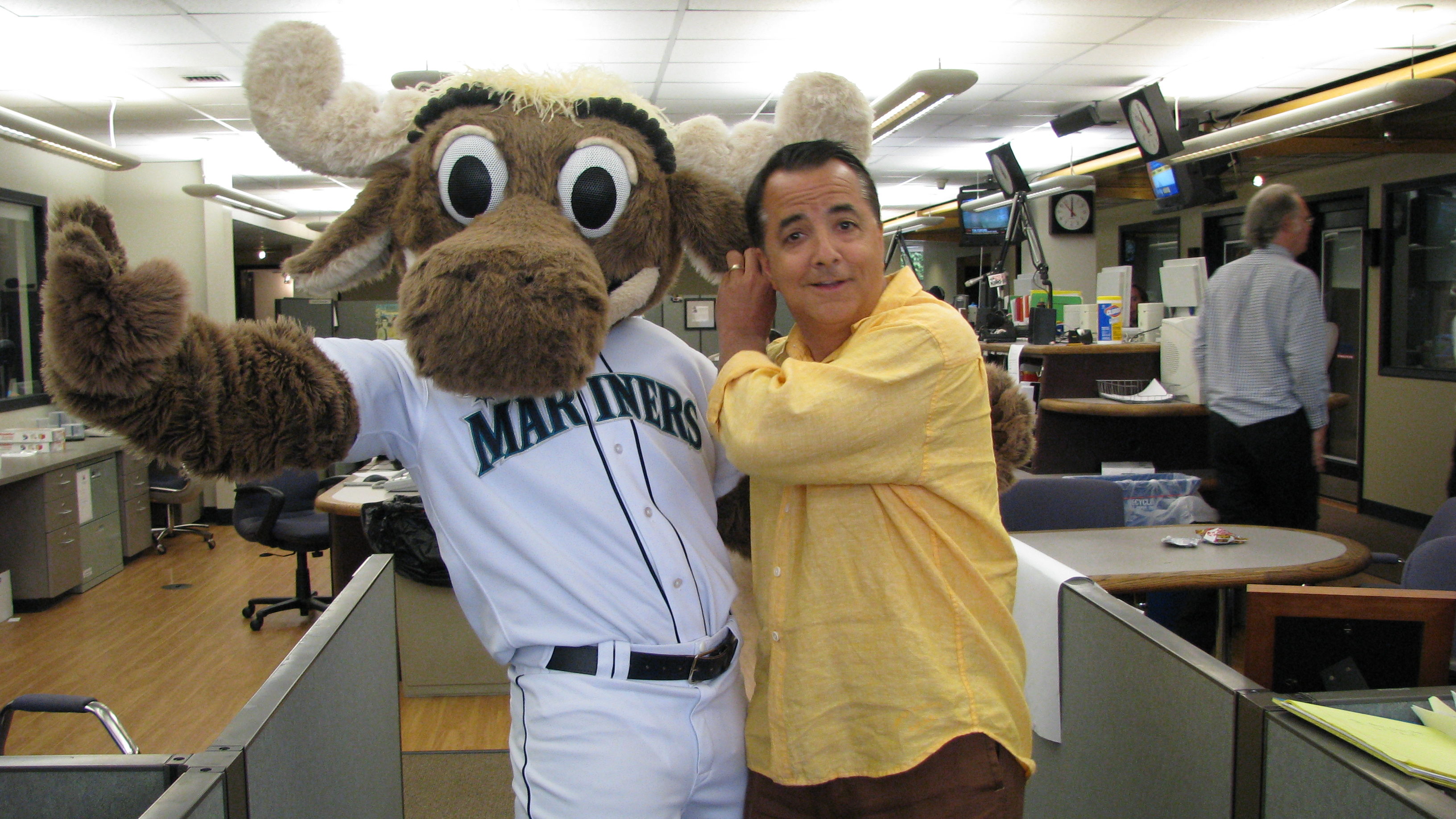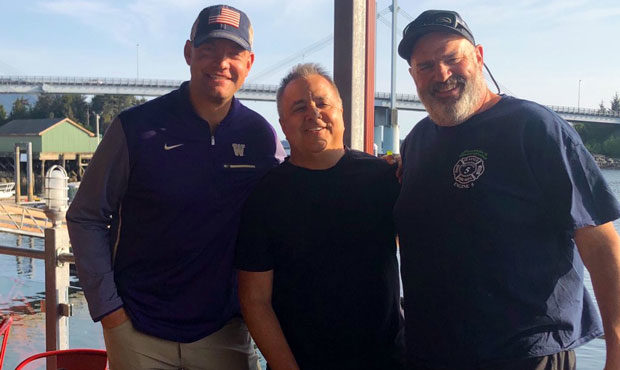Whale watching moratorium called vital part of recovery
Feb 7, 2019, 2:02 PM | Updated: Feb 11, 2019, 9:23 pm

In this photo taken Tuesday, July 24, 2018, provided by the Center for Whale Research, a baby orca whale is being pushed by her mother after being born off the Canada coast near Victoria, British Columbia. The new orca died soon after being born. (David Ellifrit/Center for Whale Research via AP)
(David Ellifrit/Center for Whale Research via AP)
This is the first part of a two-part feature on Southern Resident orca recovery. Click here for part two.
Take a sail through the San Juan Islands or to the Olympic Peninsula one summer day, and no doubt you’ll see whale watching boats dotting the waters of Puget Sound, as people from around the world gather together, bound by a common love of the orcas.
But it’s this very practice that some environmentalists say is endangering the lives of Southern Resident killer whales, contributing to their status as endangered.
The Southern Residents are a species of orca, or killer whale, native to the Pacific Northwest. There are just 75 remaining Southern Residents in J, K, and L pods. Last year proved deadly for the Southern Residents, with the loss of J50 (Scarlet), L92 (Crewser), and the calf who did not live long enough to be named, but was carried for 17 days by his grieving mother, J35 (Talequah).
RELATED: Orca task force issues final recommendations, including whale watch halt
In response to the Southern Residents’ alarming situation, Washington Governor Jay Inslee established the 48-member Southern Resident Orca Task Force in March 2018. After six meetings over the spring, summer, and autumn, the task force brought forward 36 recommendations in its final report pertaining to the following four goals:
- Increase Chinook abundance (Chinook salmon are the Southern Residents’ main food source)
- Decrease disturbance of and risk to Southern Resident orcas from vessels and noise, and increase their access to prey
- Reduce the exposure of Southern Resident orcas and their prey to contaminants
- Ensure funding, information and accountability mechanisms are in place to support effective implementation
“The orcas are facing all three threats, of lack of food, too much noise and disturbance, and too much pollution,” said Mindy Roberts, People for Puget Sound program director at ecological nonprofit Washington Environmental Council and a member of the task force.
According to the task force, one of the key ways to accomplish the goal of decreasing noise and vessel disturbance to the orcas is for whale watching vessels to stop following Southern Residents.
“I am also proposing a temporary suspension of whale watching,” Inslee declared in his biennial budget speech on Dec. 12. “It’s the right thing to do, I believe.”
It’s a proposal that is quickly moving forward toward becoming law. In late January, House Bill 1580 and Senate Bill 5577 were introduced in the Legislature. The bills call for vessels (apart from government vessels) to stay 400 yards behind Southern Residents (the status quo is 200 yards), create a “go-slow zone” that requires vessels to stay at or under 7 knots when within half a nautical mile of the Southern Residents, and ban Southern Resident whale watching through the end of the year 2022.
Commercial whale watching operators are prohibited from approaching or intercepting within 650 yards in any direction of a southern resident orca whale until January 1, 2023.
Amy Windrope, Region 4 director for the Washington Department of Fish and Wildlife and a task force member, said that whale watching vessels are required to stay 250 yards further away from Southern Residents than other commercial vessels is because whale watching vessels follow and sit by the orcas, rather than moving past them on the way to another destination.
In its report, the task force acknowledged that ten of the 36 recommendations would require legislation; besides the proposed legislation in these bills, other recommendations that would require a change on the books include revising laws to better protect the Chinooks’ habitat (the subject of HB 1579 and SB 5580), creating an Orca Protection endorsement, discouraging echo sounders and underwater transducers within a kilometer of the Southern Residents, and reducing the threat of oil spills (featured in HB 1578 and SB 5578).
Several other recommendations may not require a change in laws, but will require additional funding — something addressed by Inslee’s budget, which sets aside $1.07 billion for orca recovery.
“The bills that he’s put on the table and the budget he’s put on the table is really a significant improvement, and, if implemented, will make a difference for the Southern Residents,” Windrope said. “At [WDFW], we are really heartened.”
Roberts said that the task force hopes that all of these recommendations will begin going into effect as soon as possible — and not in a watered-down form. Task force members are currently working toward this end in the Legislature.
“[Orca decline] happens because of things that we have done, across our state, in urban communities and rural communities as well,” Roberts said. “So when we think about what it is going to take to turn around the Southern Residents — that is why we fought hard for all 36 actions. We won’t apologize for the number of them.”
Threats toward Southern Residents
The faster a vessel is, the louder the noise it creates for the whales, Roberts explained. Seven knots is the speed mandated in the new bills, but really, she said, vessels should slow down to two knots.
“The noise and disturbance from vessels interferes with the orcas’ ability to find food, and also to communicate with each other,” she said.
In fact, according to studies, the noise from the vessels reduces whales’ foraging by 17 to 21 percent. Vessel noise interrupts the orcas’ echo-location, which is their main mechanism for finding prey, Windrope explained.
“The Southern Residents are essentially blinded about five hours a day,” she said. “And so if we can reduce that time, then the available prey that’s out there can be found more easily, and with less energetic costs to the Southern Residents.”
Cutting the vessel noise by 10 decibels would decrease the echo-location interference by about half, Windrope said. Just banning whale watching could reduce the noise by as much as seven decibels.
Roberts has firsthand experience of the power of vessel noise underwater from a scuba diving trip she took.
“While we were underwater in a really narrow passage, a vessel went by really, really fast,” she said. “And the noise was painful to my human ears underwater. That was when I first understood just how big of an impact noise could have.”
Roberts pointed out that Southern Residents in the sound are surrounded by between 16 and 22 vessels at any given time.
“Those boats tend to be around them pretty much from sunrise to sunset,” she said. “So on average, [about] 12 hours.”
However, Ken Balcomb, founder of San Juan Island’s Center for Whale Research and a task force member, disagrees that the speed of whale watching vessels has any great impact on orcas — and he informed Governor Inslee that the moratorium was “ridiculous.”
“When the whale watchers are actually watching whales, they’re at idle or slow speeds, and there’s not very much acoustic energy getting to the whales,” he said. “A large ship passing by at three or four miles makes an order of magnitude more noise, so it’s really the shipping that’s the greatest noise interference.”
He called the statistic that noise reduces their foraging by 17 to 21 percent “hypothetical,” since “there was no actual measurement at the whale.”
Balcomb said that the Center for Whale Research had a recording device that was “drowned out” by large fishing vessels and military ships passing by.
“If we removed all vessels, and the military, then possibly you’d have a pristine, ambient environment and you couldn’t blame human noise,” he said. “But nobody is suggesting that.”
A race against time
One point that Balcomb and Roberts can agree on is that the Southern Resident population is going down — and that time is of the essence.
Roberts said that environmentalists have been watching the orcas’ declining numbers since the 1990s, but the “slow decline has not triggered enough response to change the decline.”
The 1993 film “Free Willy” greatly impacted the whale watch community, according to Peter Hanke, owner of whale watching company Puget Sound Express and a Port of Port Townsend commissioner, as it raised people’s awareness of the orcas at a time when their numbers were beginning to fall.
Among the Southern Residents, only about six females are having babies from one male. Female Southern Residents are capable of getting pregnant between the ages of about 15 and 40.
Balcomb said that at a high rate, a female orca would have a baby every three years (since pregnancy lasts 18 months, followed by a nursing period) — but right now that rate is closer to every 10 years. The new baby spotted among the Southern Residents in January marks the first successful birth in three years.
“Once the reproduction fails in the population, extinction is inevitable,” Balcomb said. “We’re not quite there yet, but we’re close, and we’d better start feeding them.”
Task force debates
There was only one member of the Pacific Whale Watch Association — a group of 32 whale watching tour companies from around the Puget Sound, Vancouver Island, and British Columbia’s Lower Mainland — appointed to the task force.
As such, said Hanke, many PWWA members felt that their voices were not heard, or that they were made out to be the profit-first business minds who didn’t care about conservation.
“The task force and the government are looking for an easy culprit, and they want to blame whale watchers,” Balcomb said.
The PWWA states on its website that it is “committed to direct conservation, using our extraordinary access to these sensitive populations of marine mammals to help protect them for generations to come.”
“As the task force went through their deliberations, they really didn’t give … us our due in terms of what we can do, one from patrolling around the orcas, and two, from educating the population in terms of what the plight of the orcas [is],” Hanke said, adding, “We feel like we were painted in a fairly negative light, when I think we could have really added a lot to the conversation.”
Several local whale watching tour companies declined an interview for this story, and instead referred to a statement released by the PWWA.
As the Legislature, the Governor’s Task Force, and the public continue working towards ensuring the safety of the Southern Residents, the conversation around these issues needs to remain focused solely on science-based actions that will best support the future of these whales … Responsible ecotourism is a healthy and critical piece of conservation and education.”
Puget Sound Express, like the other whale watching companies in the region, follows the guidelines set by Be Whale Wise, a partnership of the National Oceanic and Atmospheric Administration, WDFW, Friday Harbor’s Whale Museum, the Department of Fisheries and Oceans Canada, and the San Juan County Marine Resource Committee.
“Early on we’ve recognized — and in our own whale watch guidelines have made adjustments — in terms of trying to keep ourselves away from the Southern Residents,” Hanke said.
Hanke said that the whale watch community had hoped that the task force’s recommendations would be something like increasing the distance between tour boats and Southern Residents from 200 to 300 yards, or limiting the number of whale watching boats that could be out at any time. Instead, it was a moratorium that, he finds, is “not very well-defined.”
How exactly the moratorium will be enforced will largely be up to WDFW, Roberts said.
Balcomb remains skeptical of the task force’s process, critiquing the amount of science in the conversation.
“There was plenty of political input, but the biological input was pretty minimal … it was not a technical expert meeting, it was a political meeting,” Balcomb said.
Despite the frustrations, Hanke is glad that the parties came together to discuss orca recovery.
“I really appreciate what the task force has done in terms of the amount of energy they’ve put into trying to understand the problem,” he said, calling it “an invaluable effort” that “provides everyone with a forum — scientists as well as the public — to get all the cards on the table.”













